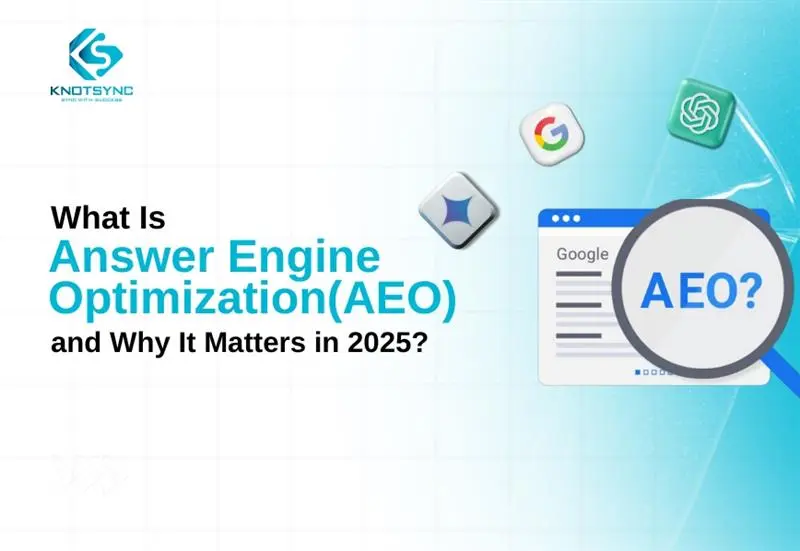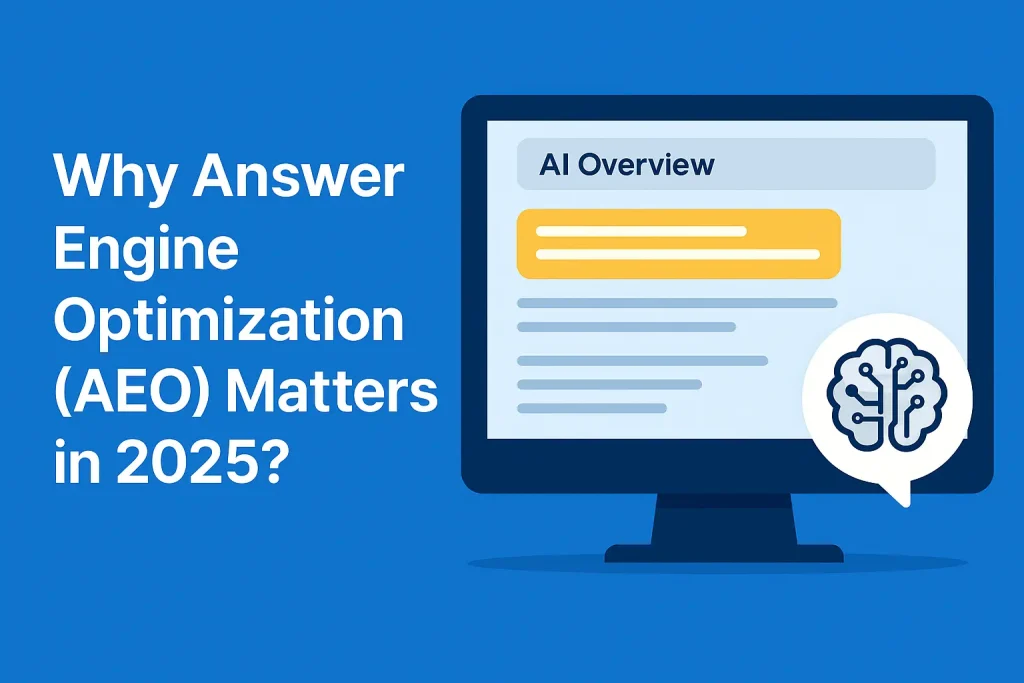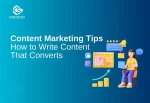Remember when searching online meant opening five tabs and skimming through blog posts just to get one clear answer?
That’s not how it works anymore.
Thanks to answer engines like Google’s AI Overviews, ChatGPT, and Perplexity, users now get full, direct answers, and that too right on the results page.
No clicks. No scrolling. Just instant information.
In fact, approximately 60% of Google searches in the United States ended without a single click in 2024. That number is only increasing as AI continues reshaping how we search.
Welcome to the era of Answer Engine Optimization (AEO)—where visibility depends less on ranking at the top of SERPs, and more on showing up inside AI-generated responses.
This is as big as mobile-first was in the early 2010s.
We’re no longer navigating websites for answers. We’re expecting the answers to come to us. And AI-powered search engines now provide responses directly on the results page for us.
Google’s featured snippets, AI Overviews, and answer boxes have turned search engines from directories into destinations.
For content creators, marketers, and business owners, that means one thing: the rules of visibility have changed.
If your content isn’t showing up inside AI responses, it’s basically invisible.
This isn’t just a UX upgrade. It’s a full-blown change in user behavior, and it’s redefining how we approach SEO.
So, what should we do about it? The answer is Answer Engine Optimization (AEO)
What You’ll Learn Today
- What AEO is and how it differs from traditional SEO?
- How Answer Engine Optimization Works?
- Why Answer Engine Optimization (AEO) Matters in 2025?
- Which type of content is cited in AEO answers?
- 7 actionable AEO techniques that work in 2025
- FAQs Regarding AEO
- Future of AEO
What is Answer Engine Optimization?
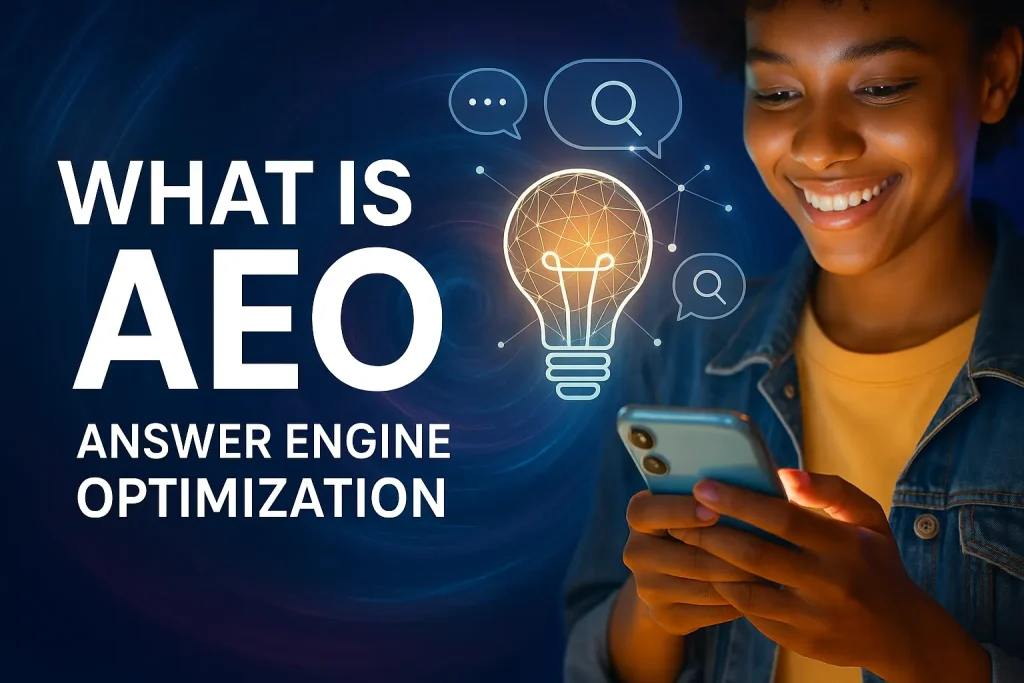
Here’s the uncomfortable truth that marketers want to forget. Most people don’t click on search results anymore, including you. They just want the answer — right there, no extra steps.
That’s before we even factor in AI tools like ChatGPT, Perplexity, or Google’s new AI Overviews, which don’t just show results; they generate answers.
That’s where Answer Engine Optimization (AEO) comes in.
It is the practice of structuring your content so AI tools can easily find, understand, and quote it.
According to Neil Patel, AEO is optimizing your content so that it becomes the direct answer for queries in AI platforms like ChatGPT, Bard, and Alexa. It focuses more on providing concise, verified, and valuable answers rather than simply ranking.
It’s like SEO but built for an AI-first world, where visibility isn’t about ranking #1, it’s about being the answer.
Instead of competing for clicks, you’re competing for citations. To be the source that AI pulls from when someone asks a question.
These answers can be in any form, including featured snippets, lists, videos, and voice search results.
Let’s understand this with an example.
You used to optimize a blog to show up when someone searched “best restaurant in Alabama.” With AEO, you write so clearly and helpfully that ChatGPT itself recommends your content when someone asks the same question.
Goin forward, AEO will be mandatory for brands to stay visible.
If SEO was about getting found, AEO is about getting trusted. And in the long run, trust is what drives decisions.
How is AEO Different from Traditional SEO?
While SEO helped businesses rank in traditional search engines, Answer engine optimization or AEO helps brands appear in AI-generated answers. The kind users trust, read, and act on without ever visiting a website.
It’s a major shift in how search works. Where SEO is about earning clicks, AEO is about earning citations. You’re not just fighting for Position #1 on Google anymore. You’re fighting to be the answer AI tools choose to display.
To understand the difference between AEO and SEO, here’s a side-by-side breakdown of SEO vs AEO:
Factor |
SEO (Search Engine Optimization) |
AEO (Answer Engine Optimization) |
| Goal | Rank higher on search engine results pages (SERPs) | Get included in AI-generated answers across tools like ChatGPT, Perplexity, Google SGE |
| User Intent | Users browse links to find relevant information | Users want direct, contextual, conversational answers — no need to click |
| Primary Audience | Human users using traditional search engines (Google, Bing) | AI systems that scan, understand, and cite trusted sources |
| Content Structure | Long-form, keyword-optimized, sometimes clickbait-driven | Clear, concise, structured content (FAQs, definitions, lists) optimized for AI parsing |
| Content Tone | SEO-friendly, persuasive or salesy | Fact-driven, contextual, conversational (like how humans talk to AI assistants) |
| Optimization Method | Keyword research, backlinks, meta tags, internal linking | Schema markup, structured data, question-answer format, topical authority |
| Format Focus | Blogs, landing pages, category pages | FAQs, glossary pages, how-to guides, featured snippets, semantic markup |
| Result Type | Website traffic, impressions, CTR | Brand mentions in AI answers, citations, co-referencing, click-less visibility |
| Measurement Metrics | Rankings, traffic, bounce rate, backlinks | AI citations, mentions in answer summaries, structured data presence, visibility in AI |
| Search Model | Pulls list of documents based on keyword relevance | Synthesizes and generates responses from trusted sources and context |
| Time-to-Value | Medium to long term (via ranking build-up) | Medium to long term, but sometimes faster visibility via emerging answer engines |
| Examples of Success | Ranking #1 on Google for “best running shoes 2025” | Being cited by ChatGPT for “What are the best running shoes for flat feet in 2025?” |
| Underlying Model | Based on link equity, keyword relevance, domain authority | Based on semantic understanding, trust, credibility, structured data |
| Main Optimization Tools | Yoast SEO, Ahrefs, SEMrush, SurferSEO | Also uses SEO tools, but adds tools like Schema Markup Generator, GPT citations monitor |
How Answer Engine Optimization Actually Works?
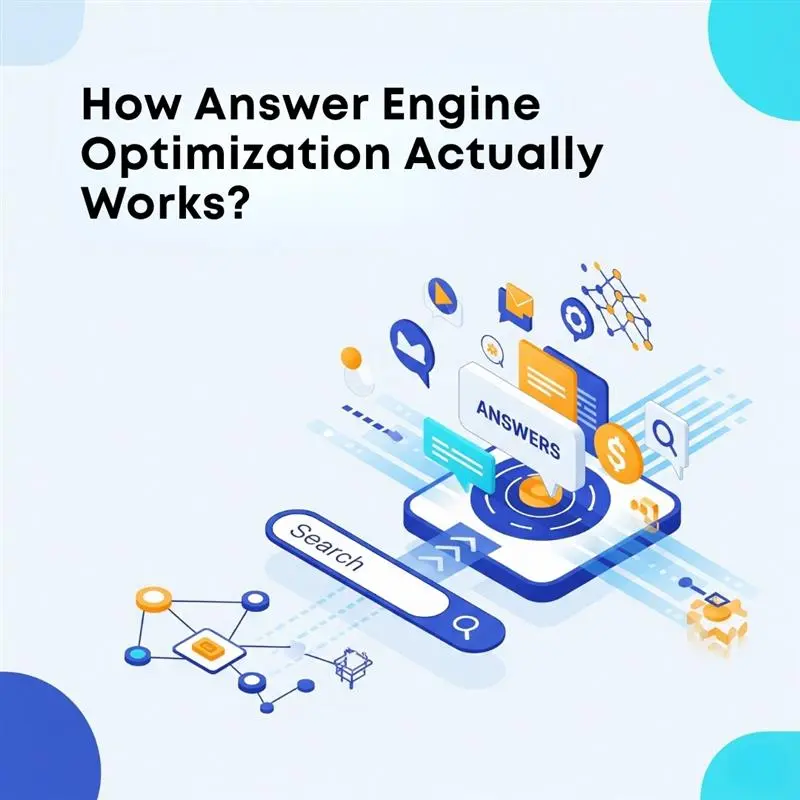
Let’s say you type this into ChatGPT:
“Best running shoes for flat feet under $100.”
You’re not asking for a definition of “footwear.” You want recommendations like budget-friendly options tailored to your running style.
Modern AI models are trained to understand exactly that.
So much happens behind the scenes to give you a reply that matches your intent.
The whole process of AEO understanding a query and giving the right answer involves the following process:
LLMs Break Down Your Query Using NLP
Unlike SEO, where keywords were everything, answer engines don’t just match your keywords. They analyze your query to know your intention for the search.
The first thing these models do is parse your query using Natural Language Processing (NLP). That means they don’t just look at individual keywords. They understand the intent, context, and even the urgency behind your words.
They understand that:
- “Best” signals a comparative need
- “Flat feet” hints at a specific user persona
- “Under $100” adds a price filter
- And “running shoes” isn’t just a product; it ties into comfort, motion control, and injury prevention
Use Training on Billions of Webpages to Find Meaning in Context
AI models are trained on massive datasets and billions of web pages.
They’ve learned patterns in language and know the meaning of the same word in different contexts. They also understand how to reason through problems and how meaning shifts based on phrasing and tone.
That is why they know when someone asks:
- “How to tie shoes?” → They want a step-by-step tutorial
- “Why do shoes come untied?” → They’re looking for a mechanical or behavioral explanation
This contextual understanding is the foundation of AEO. Your content must match the topic and the form of help the user seeks.
Search for the Most Relevant, Helpful, and Trustworthy Data – Not Just the Top Results
Once the models understand what the user wants, they look for appropriate answers by searching through:
- Billions of web pages
- Structured databases
- Knowledge graphs
- Real-time information sources
- Trusted publications and academic sources
They cross-reference information from multiple sources (Articles, videos, FAQs, and UGC), verify facts, evaluate source credibility, and prioritize recent, authoritative content.
And here’s the key: they’re not just looking for keyword matches or top-ranked pages. They are searching for content that directly answers the question, in the format and tone the user expects.
So, if your blog includes:
- A clear product comparison table for running shoes under $100
- A section that explains which types work best for flat-footed runners
- And advice sourced from real users or experts
Then, the models will see your content as valuable, relevant, and trustworthy and show it within the answer engines.
Blend Relevant Snippets to Provide Answers in Real-time
AI models synthesize a human-like response after looking for information across multiple sources.
For example, they might say:
“If you’re a runner with flat feet looking for affordable shoes, models like the Brooks Launch GTS 10 or ASICS Gel-Contend 7 are frequently recommended. They offer arch support without going over budget, and users say they help with long-distance comfort.”
Since the answers provided by AI models are not just being indexed, they are being quoted or absorbed into the model’s generative flow.
Answer engine optimization isn’t about hacks or stuffing keywords. It’s about structuring your content to align with:
- The question being asked
- The way models interpret that question
- And the format in which they like to answer
The answer is then presented in the following ways:
- In featured snippets
- In “People also ask”
- As AI summaries
- Or spoken aloud via a voice assistant
AI models even anticipate your next question and provide a comprehensive answer before you have even asked it.
Which Type of Content is Cited in AEO Answers?
As Google’s AI Overviews (AEO) are making searches more conversational, content creators have a huge opportunity to get discovered in smarter, more targeted ways.
It’s no longer about ranking on page one. It’s about becoming the answer.
As Elizabeth Reid, Head of Google Search, Search Engine Land, recently said:
“What you see with something like AI Overviews, when you bring the friction down for users, is people search more, and that opens up new opportunities for websites, for creators, for publishers to access. And they get higher-quality clicks.”
But here’s the catch: not all content ends up in these AI-generated summaries.
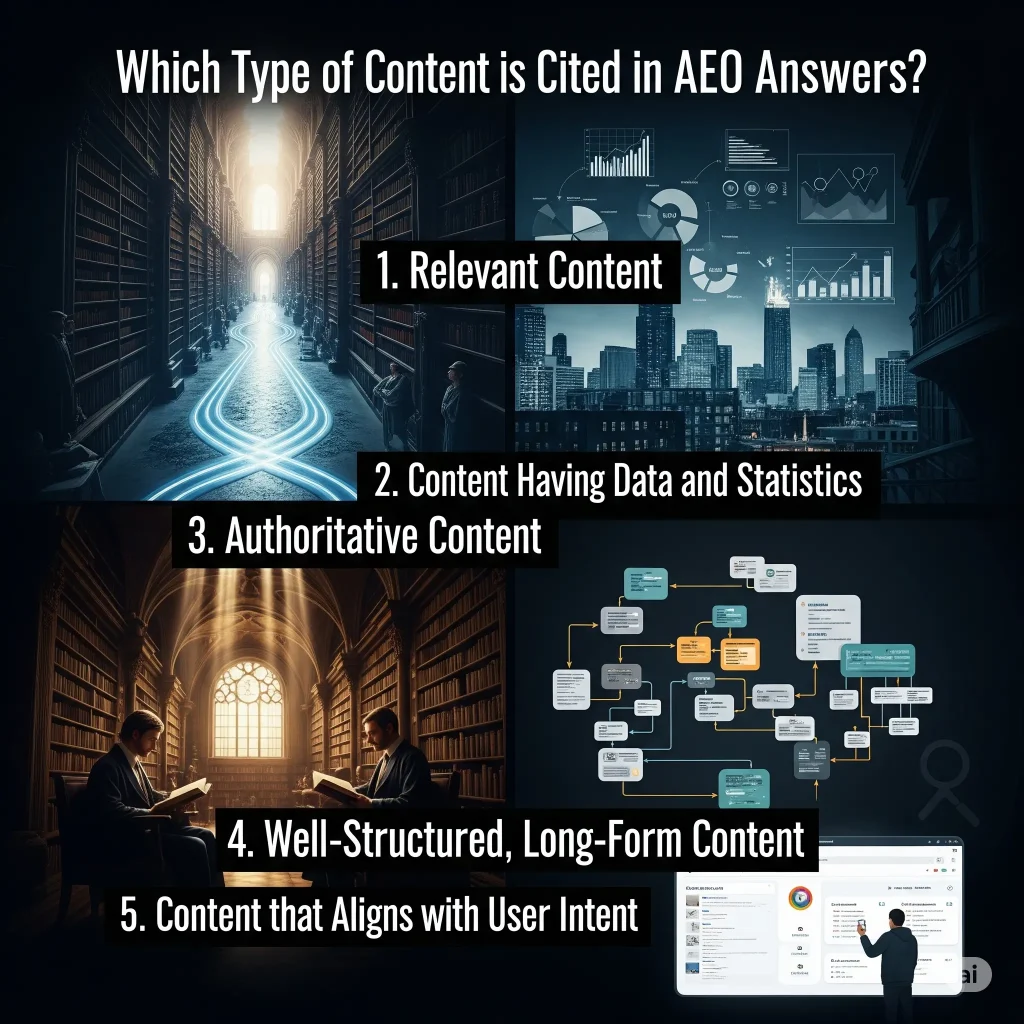
So, what kind of content actually gets pulled into AEOs?
Let’s find out the 5 types of content that AI cites.
1. Relevant Content
AEO isn’t grabbing random paragraphs. It prioritizes content that aligns precisely with the user’s query and focuses on direct, relevant answers to those queries.
If someone searches: “Best project management tools for remote teams,” a vague blog titled “How to Be Productive While Working Remotely” won’t cut it.
But something like “5 Project Management Tools Every Remote Team Should Use (With Collaboration Features & Pricing”)? That’s exactly the kind of intent-matching content AI Overviews love to pull since it focuses on topical depth and specificity.
2. Content Having Data and Statistics
AI models treat numbers like trust signals.
They aren’t just parsing words — they’re verifying claims. So, AI models are more likely to pick your content when your content backs up a statement with clear data points, original research, or reliable statistics.
It’s not just about opinions. Credible numbers catch AI’s attention.
Let’s say you’re writing about email open rates. Saying “they’ve improved recently” is forgettable. But citing:
“According to Campaign Monitor, average open rates rose to 21.5% in 2024.”
gives it weight.
These quantifiable insights not only increase credibility. They also make your content more indexable, shareable, and citeable in the eyes of an AI.
3. Authoritative Content
LLMs are like smart librarians. They’ve read everything, but they still prefer high-quality and trusted sources.
They favor content that consistently demonstrates expertise on a particular topic.
Whether it’s from a major publisher or a respected niche voice, content with consistent expertise is more likely to get cited.
Think of it as a digital reputation.
A well-known SaaS writer who has written 50+ deep dives on product-led growth? Trusted by AI models.
A no-name site with AI-generated fluff? Probably ignored.
4. Well-Structured, Long-Form Content
Long blogs alone don’t win. But such blogs + structure? That’s gold.
AI tools tend to extract responses from long-form content that’s written to be scanned by humans and machines.
Think long-form blogs with smart formatting:
- Clear H2/H3 headers
- Short paragraphs that explain a single topic
- Bullet points to organize dense ideas
- Uniform formatting for readability
- Key takeaways that recap the value
The more digestible your content is, the more likely an AI model is to extract useful insights from it and cite your website as a source.
5. Content that Aligns with User Intent
Back in the day, you could trick search by stuffing a keyword 20 times on a page.
Today? AI reads between the lines. It interprets what the user actually wants to know, not just what they typed.
Rather than focusing solely on keywords, AI tools understand the broader intent behind user queries and cite content that is relevant and useful.
This means it looks for content that genuinely addresses the user’s goal—whether it’s to compare tools, solve a problem, or learn about a process.
If someone searches “how to grow your startup,” they are not asking for a motivational quote. They might want frameworks, tools, hiring strategies, or even role charts.
So, a blog titled “5 Startup Roles You Need Before Hiring a CMO” is more likely to get picked than one called “Why Startups Struggle.”
Because it’s not just relevant — it’s goal-oriented, solution-focused, and practical.
TL; DR:
The content cited by AI Overviews isn’t just technically correct. It’s relevant, data-driven, trusted, well-structured, and aligned with the deeper meaning behind the query.
If you write like you’re helping a real person solve a real problem in real time, the engines will notice.
Why Answer Engine Optimization (AEO) Matters in 2025?
Since the start of 2025, AEO interest has surged, driven by the explosion in Large Language Model (LLM) usage across the web.
And companies that saw this coming? They’re already reaping the rewards.
Companies that implemented AEO early in 2024 now see 3.4x more visibility in AI-generated responses than competitors who waited.
Why? Because AI tools only look for clear, structured, high-quality content.
And early adopters gave it to them.
This trend is even stronger on mobiles.
With limited screen space, users want fast, bite-sized, conversational answers that load instantly. That’s why featured snippets, AI Overviews, and summary boxes are taking up prime real estate—and driving the majority of engagement.
There are some other reasons why AEO matters more today. Let us check out why.
Zero-Click Searches Are the New Normal
More than 58% of Google searches now end without a click.
And it’s not just Google anymore.
With ChatGPT, Bing Copilot, and Perplexity all integrating real-time web search, we’ve entered a zero-click world where not being cited is being forgotten.
Google’s AI Summaries Are Pushing Your Content Off the Page
Google’s Search Generative Experience (SGE) has already been live for millions.
The layout? Completely different.
AI-generated summaries appear at the top of search results, way above organic listings. That often means your top-ranking blog is buried below the fold on mobile.
Early tests show that CTR drops by 30–45% when SGE is active.
With AEO, you’re not chasing position one anymore.
You’re aiming to be the answer that Google’s AI picks first.
No Mention in AI Answers Means You’re Invisible
Here’s what most businesses miss. They do not show up in AI summaries. It isn’t just a visibility problem—it’s a revenue leak.
Most people today use ChatGPT or other AI tools to get what they are looking for instead of using traditional searches.
It means that if your business is not showing in the AI searches, you are as good as not having any online presence and losing potential customers.
But AEO gets your content exactly where it matters—in the moment of decision.
Change in the User Behavior
In the past few years, the search behavior of internet users has been changing.
An increase in mobile-first browsing, the introduction of voice search, and the advancement in AI have led to users looking for answers directly in search engines.
They want immediate answers without clicking a single website.
And if you don’t show up where it matters to them, you don’t even exist for them.
To Compete with Businesses Having Big SEO Budgets
If you are an entrepreneur and just getting started, you might not have a big budget for SEO, unlike large enterprises that have thousands of dollars for this purpose.
And traditional SEO only rewards those who have a strong SEO game. As a result, top spots on SERPs are mostly taken up by established businesses that have been in the industry for decades.
It shifts the balance of power in their favor and makes it almost impossible to outrank them.
But AI models have changed the game.
You might not even need to rank at all.
They can pull up your content even if it ranks on the 30th page of SERPs if it is unique, has a clear structure, and matches user intent.
AEO can make your content worthy of citation with things like:
- Semantic clarity (explain things like you would to a smart 12-year-old)
- Structured data (like FAQs, tables, headings)
- Schema markup
- Direct answers
To Answer Voice Search and Conversational Search Queries
As of 2025, there are around 8.4 billion voice assistants in use. According to the global state of digital in April 2025, 31.5% of internet users aged 16+ used voice assistants like Siri or Alexa each week in the fourth quarter of 2024.
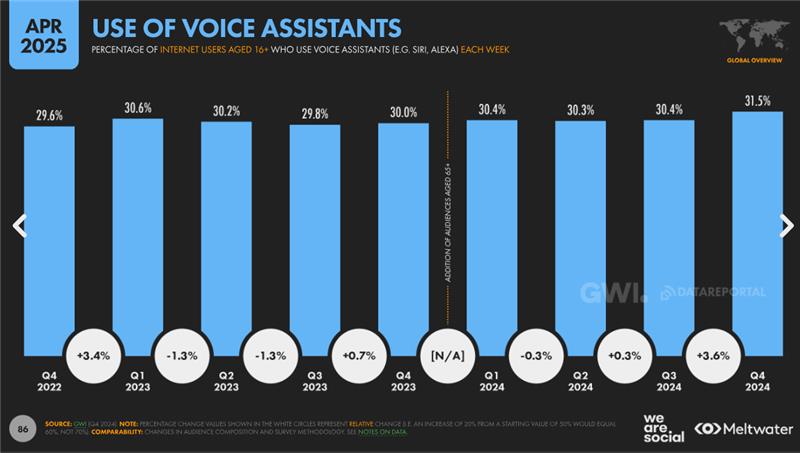
It shows that the popularity of voice search is growing. And the number of people who like convenience and natural language when searching is increasing.
Hence, there is a need to optimize for voice search.
The voice search queries aren’t just short commands. They’re full of questions, follow-ups, and conversational queries.
You can only answer these queries if you have optimized your content for answer engines.
AEO is about optimizing for how people actually talk and creating content that responds to user queries in complete sentences and answers those spoken questions clearly.
7 Actionable Answer Engine Optimization (AEO) Techniques that Work in 2025
Since AEO (Answer Engine Optimization) has become a crucial part of how brands get discovered, we must now actively optimize for it, not just for Google, but for AI tools like ChatGPT, Perplexity, and Google’s AI Overviews.
These platforms pull data from Reddit threads, review platforms, product documentation, media mentions—even long-tail blog content on page 5 of Google—if that’s what answers the query best.
So, how do you ensure your brand, content, and voice show up?
Let’s break down 7 actionable strategies to optimize for AEO in 2025. These aren’t just tips—they’re actionable techniques backed by data, designed to help your brand show up, stand out, and get cited across the modern AI-powered internet.
1. Build a Strong, Positive Online Presence
Based on the user query, AI models might pull answers from a website ranking on page 3 or lower to provide a synthesized response to you. It will ignore the site on page 1 if it finds the content useful.
If you want to rank for those queries, you need to make sure what people (and AI tools) see, hear, and repeat about your brand online is what you intend.
Rand Fishkin, CEO of Sparktoro, rightly says, “The ability to influence how people write about, talk about, and publish about you on the web directly impacts how AI tools respond to questions about your brand, your field, and whether they include you when prompters ask about the problems you solve.”
This means that content on your website, social media, reviews, mentions, and anything AI might use to summarize, you must show yourself or your business in a positive light.
Make sure you own your brand’s digital story. If you don’t, someone — or some AI — will write it for you. And in today’s AI-powered search world, that version is what customers believe.
If you offer software or business solutions, maintain a positive image on product review sites like G2.
Local and consumer-facing brands providing services related to travel, dining, and depending on reviews for good publicity, must control brand image on review platforms like TripAdvisor and Yelp.
When you get any negative reviews, reply to them within 48 hours. It will help maintain a positive brand image.
If any user provides feedback to improve your products and services, reassure them that you will work on the feedback. It demonstrates responsiveness to customer needs.
2. Focus On Content that Directly Answers User Query
Since internet users are getting used to seeing direct answers, try to provide them with the information they want in a clear, concise manner.
Prioritize clarity, relevance, and value. Make sure you create content only after understanding the intent behind why someone is asking that question.
Your answer should reflect a real, contextual understanding of what the user wants.
While creating content to address user queries, make sure to:
- Give headings as it helps AI scan your content easily.
- Create a proper structure with relevant sections.
- Write short paragraphs in simple language to assist AI models in better understanding your content.
- Use bullet points wherever possible.
3. Give AI Models Trust Signals
Since AI models go through diverse sources before synthesizing an answer, give them as much data as possible that makes you trustworthy and demonstrates your expertise. It will strengthen your brand’s online presence and maximize visibility across AI search results. You can do this by:
- Citing and giving references from credible sources in your niche.
- Reaching out to industry experts and getting their quotes to provide a real-world perspective.
- Ensuring factual accuracy.
- Supporting your claims with recent statistics (from the past 1 or 2 years).
- Providing an author bio for your content piece.
- Updating existing articles or other content regularly with recent data.
4. Engage in Reddit Discussions
Profound analyzed 30 million citations across ChatGPT, Google AI Overviews, and Perplexity from August 2024 to June 2025.
It found that ChatGPT’s top source for citation (within its top 10 cited sources) was Wikipedia, followed by Reddit, while for Google AI Overviews and Perplexity, the top source was Reddit.
| Platform | Top Cited Source (Within each platform’s top 10 cited sources) |
| ChatGPT | Wikipedia |
| Google AI Overviews | |
| Perplexity |
It shows that Reddit has a great influence on how people see you.
Moreover, Perplexity and OpenAI have Reddit API integrations, while Google has expanded its Reddit partnership.
So, identify and contribute to relevant Reddit threads related to your business (e.g., r/SaaS, r/ProductManagement).
Try to be helpful and give valuable insights while answering Reddit questions rather than promoting your content.
Remember, Reddit users can smell bullshit from miles away. They would know when you are trying to help genuinely and when you are promoting yourself.
Be helpful, contribute to meaningful discussions, link to your resources where appropriate, and build good rapport with community members. AI models will pull your answers if people find them useful, and they offer actual value.
5. Optimize for the Platform that Matters Most to Your Audience
The same study we discussed above by Profound showed that different AI platforms have different source preferences.
ChatGPT heavily relies on Wikipedia and then on Reddit. If you want ChatGPT to cite your site, optimize your content for both platforms.
It also retrieves information from the B2B software review site G2, as you can see in the table below. If it’s applicable for your business, try creating and maintaining a business profile on G2 and encouraging your customers to leave a positive review.
| Platform | G2 (%) | Gartner (%) | TripAdvisor (%) | Yelp (%) |
| ChatGPT | 6.7 | N/A | N/A | N/A |
| Perplexity | 4.0 | 7.0 | 4.1 | 5.8 |
| Google AI Overview | N/A | 7.1 | N/A | N/A |
| Data from 10 million citations (Aug 2024 – June 2025) | ||||
| Note: Percentages reflect share within each platform’s top 10 sources — not total citation volume. | ||||
Perplexity focuses on localized and human-centric queries. Hence, it sources more from real-world and user-generated platforms like TripAdvisor, Yelp, G2, and Gartner, as seen from the table above.
So, if you own a local and consumer-centric brand and want your business featured in Perplexity, try creating a profile on the above review sites (whichever suits your business) and become visible there.
After analyzing Google AI Overviews citation patterns, it was found that there was a more balanced distribution across social platforms like Reddit, LinkedIn, and Quora, as well as video platforms like YouTube, as can be seen in the picture below.
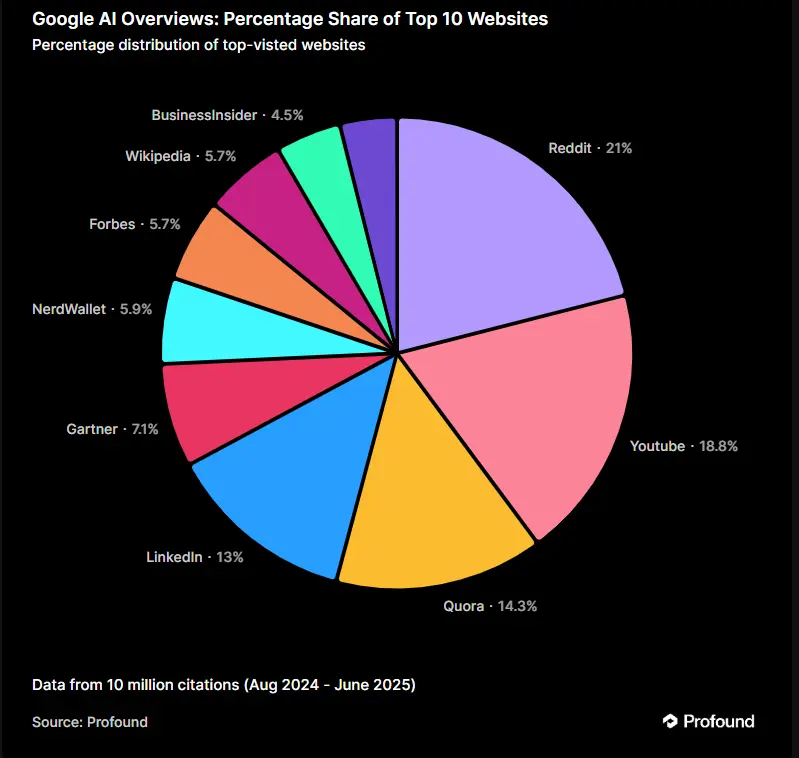
So, those targeting Google’s AI Overview should aim to get cited in high-authority sites like Gartner, Forbes, and Business Insider, or community platforms like Reddit and Quora.
Even YouTube is an excellent platform for them since it is the second most used source by Perplexity, only after Reddit at 18.8%
6. Get Mentions in Media Outlets
In 2024, OpenAI announced licensing agreements with major publishers including Vox Media, The Atlantic, Dotdash Meredith, News Corp, the Financial Times, and Reddit. This means that ChatGPT’s AI model will be trained on data from these sources.
Therefore, having a media presence is no longer an option but a necessity to get AI visibility.
So, try to get features in major publications and industry sites since AI models train on data from these sources and rely on authority signals like humans trust authoritative sources.
The more robust and positive your brand’s presence in online publications, the more likely AI will include your insights or mention your name when relevant.
Journalists care more about relevance and newsworthiness than whether you’re paying. So, offer expert commentary, newsworthy announcements, unique data, or trending insights to land a feature organically.
You can also distribute thought leadership stories, industry reports, case studies, and data-driven reports since these are more quotable.
In Is Digital PR The Future of Marketing? with Rand Fishkin, Rand said that PR is absolutely the future and ” that (PR) has always been the most important part of marketing and all the new AI models and training data rely on.”
So, invest in PR, especially if you are in a crowded niche and want to target high-authority outlets like Forbes, TechCrunch, and top industry sites.
After you get media coverage, share it widely across LinkedIn, X, and your company blog for maximum reach.
7. Implement Structured Data through Schema Markup
Search engines and AI tools like ChatGPT don’t just read your content like humans do. They need extra help to understand what it’s about. That’s where structured data comes in.
It helps search engines and answer engines like ChatGPT, Perplexity, and Google’s SGE understand the context and meaning of your content, not just the words.
How?
Add a code called schema markup to your website that tells AI tools what the website is about.
It will make your content categorized, contextualized, and answer-friendly. In easier terms, schema markup bridges the gap between human writing and machine understanding.
There are many types of schema markup you can use depending on the kind of content you have. Like:
- Article schema
- FAQPage schema
- HowTo schema
- Product schema
For example, if you’re writing about FAQs, the FAQ page schema helps AI understand that you are giving a list of frequently asked questions and not just writing random questions and their answers.
You can use free tools like Google’s Structured Data Markup Helper and Merkle Schema Generator to implement schema markup.
FAQs About Answer Engine Optimization
Answer Engine Optimization (AEO) is still evolving. It is newer, messier, and changing fast.
And the truth is—one blog post can’t cover it all. New platforms, new ranking signals, and new user behaviors show up almost weekly.
Just recently, Perplexity introduced “Pro Search,” and Google quietly expanded its AI Overviews across more queries. These shifts are rewriting how information is surfaced and who gets visibility.
Therefore, there are a few common questions that people have about AEO. Some of these are answered below to help you cut through the noise and take actionable steps.
1. What are the different types of answer engines?
Answer engines are designed to give users quick, direct answers, often without needing to click a link. Here are the four main types of answer engines you should know:
- Generative AI Chatbots
Tools like ChatGPT and Google Bard fall under this category. They respond to complex or open-ended questions with detailed, conversational answers. They’re ideal for deeper queries or research.
- Voice Assistants
Voice assistants like Google Assistant, Siri, and Amazon Alexa let users speak their queries and get hands-free answers instantly. They are perfect for people who want answers while multitasking or on the go.
- AI-Powered Search Tools
Platforms like Google’s Search Generative Experience (SGE) and Microsoft Copilot enhance traditional search by generating quick summaries and insights at the top of results. They reduce the need to scroll through multiple links.
- Multimodal Tools
Tools like Perplexity AI and Google Lens use a mix of text, images, and sometimes video to give richer, more visual responses. These are useful for product searches, visual identification, or complex queries.
2. AI models scrape websites to pull answers. Should I allow AI bots to crawl my website?
Allowing AI bots can boost your brand’s visibility in AI-generated answers and build authority. Some platforms may also drive referral traffic. However, bots may miss key content, not always credit your site, and could use proprietary info without permission. If visibility outweighs control for you, allow it. Otherwise, block bots using robots.txt.
3. Which tools should I use to optimize for answer engine optimization?
You can use HubSpot’s AI Search Grades (AISG) and SEMrush AI toolkit to see how AI search engines discuss your brand. Ahrefs and SimilarWeb are also great if your want to check out your site’s visibility in popular AI tools like ChatGPT, Microsoft Copilot, Gemini, Perplexity, Claude
If you want to get reviews for your business and find a review site where services or products similar to yours can be reviewed, use Ahrefs or SEMrush. They will help you discover where your competitors are being mentioned or reviewed.
You can also use advanced Google searches like:
“Your Service Type” + “review”
“Competitor Name” + “reviews”
To connect with journalists and get media coverage organically, try tools like HARO (Help a Reporter Out), Qwoted, Terkel, and SourceBottle. These platforms connect you with journalists looking for expert quotes.
You can try Profound to get a detailed analysis of how often your site appears in AI-generated results. GA4 also provides information about traffic coming from AI sources, but it has many limitations.
Future of Answer Engine Optimization

In 2025, as AI is becoming more advanced, search engines and answer engines will make it much easier for users to get information.
It will mean that your business needs to show up where the search ends—inside the answer.
You don’t just need traffic anymore.
You need trust, authority, and presence at the source of decision-making.
And that’s why answer engine optimization isn’t optional—it’s your growth strategy for the AI era. It’s the future of visibility, trust, and growth in the age of intelligent search.
So, go with the AI tide rather than against it. Adapt and embrace AEO to better meet user expectations.
Optimize your content for answer engines.
Your business also deserves to be part of the conversation happening inside answer engines. So, don’t let AI leave you out of it.
We help brands like yours get cited, seen, and rank in answer engines like ChatGPT and Perplexity.
And can help you achieve similar results. Contact us today!


